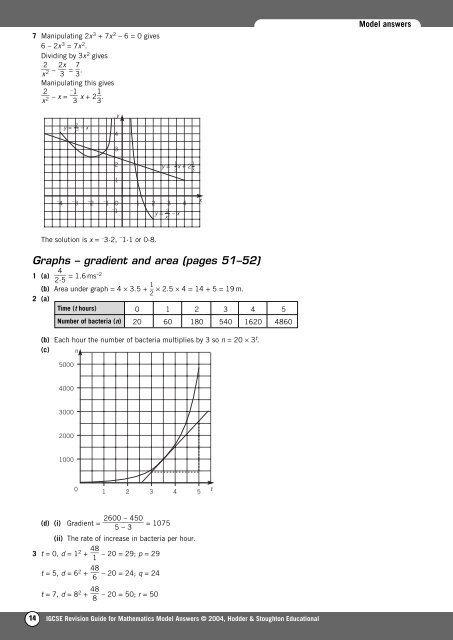Answers to all pages - Hodder Plus Home
Answers to all pages - Hodder Plus Home
Answers to all pages - Hodder Plus Home
You also want an ePaper? Increase the reach of your titles
YUMPU automatically turns print PDFs into web optimized ePapers that Google loves.
7 Manipulating 2x 3 + 7x 2 – 6 = 0 gives<br />
6 – 2x 3 = 7x 2 .<br />
Dividing by 3x 2 gives<br />
2 2x 7<br />
–– – –– = – .<br />
x<br />
2 3 3<br />
Manipulating this gives<br />
2<br />
– 1 1<br />
–– – x = –– x + 2 – .<br />
x<br />
2 3 3<br />
Model answers<br />
2<br />
y = – x<br />
x 2<br />
y<br />
4<br />
3<br />
2<br />
1<br />
y = – 1<br />
x + 2 1 3 3<br />
– 4 – 3 – 2<br />
– 1 O 1 2 3 4<br />
– 1<br />
2<br />
y = – x<br />
x 2<br />
x<br />
The solution is x = – 3·2, – 1·1 or 0·8.<br />
Graphs – gradient and area (<strong>pages</strong> 51–52)<br />
4<br />
1 (a) ––– = 1.6 ms<br />
2·5<br />
–2<br />
1<br />
(b) Area under graph = 4 × 3.5 + – × 2.5 × 4 = 14 + 5 = 19 m.<br />
2<br />
2 (a)<br />
Time (t hours) 0 1 2 3 4 5<br />
Number of bacteria (n) 20 60 180 540 1620 4860<br />
(b) Each hour the number of bacteria multiplies by 3 so n = 20 × 3 t .<br />
(c) n<br />
5000<br />
4000<br />
3000<br />
2000<br />
1000<br />
0<br />
1 2 3 4 5<br />
t<br />
2600 – 450<br />
(d) (i) Gradient = –––––––––– = 1075<br />
5 – 3<br />
(ii) The rate of increase in bacteria per hour.<br />
3 t = 0, d = 1 2 48<br />
+ –– – 20 = 29; p = 29<br />
1<br />
t = 5, d = 6 2 48<br />
+ –– – 20 = 24; q = 24<br />
6<br />
t = 7, d = 8 2 48<br />
+ ––8 – 20 = 50; r = 50<br />
14<br />
IGCSE Revision Guide for Mathematics Model <strong>Answers</strong> © 2004, <strong>Hodder</strong> & S<strong>to</strong>ugh<strong>to</strong>n Educational

















